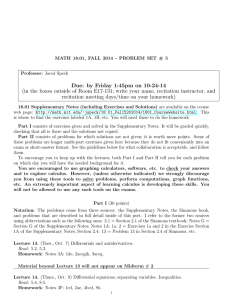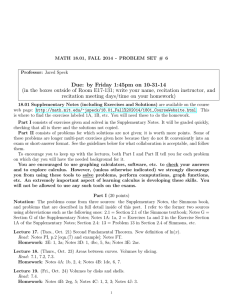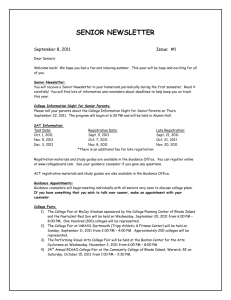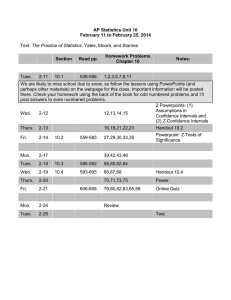Due: by Friday 1:45pm on 11-14-14
advertisement
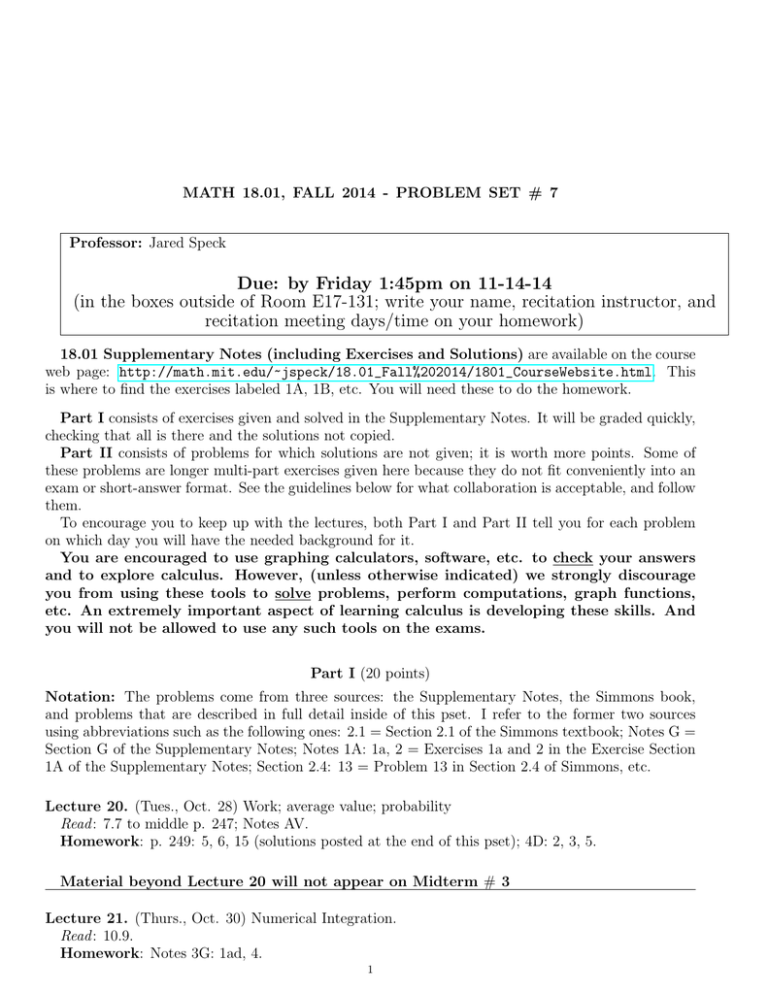
MATH 18.01, FALL 2014 - PROBLEM SET # 7 Professor: Jared Speck Due: by Friday 1:45pm on 11-14-14 (in the boxes outside of Room E17-131; write your name, recitation instructor, and recitation meeting days/time on your homework) 18.01 Supplementary Notes (including Exercises and Solutions) are available on the course web page: http://math.mit.edu/~jspeck/18.01_Fall%202014/1801_CourseWebsite.html. This is where to find the exercises labeled 1A, 1B, etc. You will need these to do the homework. Part I consists of exercises given and solved in the Supplementary Notes. It will be graded quickly, checking that all is there and the solutions not copied. Part II consists of problems for which solutions are not given; it is worth more points. Some of these problems are longer multi-part exercises given here because they do not fit conveniently into an exam or short-answer format. See the guidelines below for what collaboration is acceptable, and follow them. To encourage you to keep up with the lectures, both Part I and Part II tell you for each problem on which day you will have the needed background for it. You are encouraged to use graphing calculators, software, etc. to check your answers and to explore calculus. However, (unless otherwise indicated) we strongly discourage you from using these tools to solve problems, perform computations, graph functions, etc. An extremely important aspect of learning calculus is developing these skills. And you will not be allowed to use any such tools on the exams. Part I (20 points) Notation: The problems come from three sources: the Supplementary Notes, the Simmons book, and problems that are described in full detail inside of this pset. I refer to the former two sources using abbreviations such as the following ones: 2.1 = Section 2.1 of the Simmons textbook; Notes G = Section G of the Supplementary Notes; Notes 1A: 1a, 2 = Exercises 1a and 2 in the Exercise Section 1A of the Supplementary Notes; Section 2.4: 13 = Problem 13 in Section 2.4 of Simmons, etc. Lecture 20. (Tues., Oct. 28) Work; average value; probability Read : 7.7 to middle p. 247; Notes AV. Homework: p. 249: 5, 6, 15 (solutions posted at the end of this pset); 4D: 2, 3, 5. Material beyond Lecture 20 will not appear on Midterm # 3 Lecture 21. (Thurs., Oct. 30) Numerical Integration. Read : 10.9. Homework: Notes 3G: 1ad, 4. 1 2 MATH 18.01, FALL 2014 - PROBLEM SET # 7 Lecture 22. (Fri., Oct. 31) Trigonometric integrals. Direct substitution. Read : 10.2, 10.3. Homework: Notes 5B: 9, 11, 13, 16; Notes 5C: 5, 7, 9, 11. Lecture 23. (Tues., Nov. 04) Inverse substitution. Completing the square. Read : 10.4. Homework: Notes 5D: 1, 2, 7, 10. MATH 18.01, FALL 2014 - PROBLEM SET # 7 3 Part II (50 points) Directions and Rules: Collaboration on problem sets is encouraged, but: i) Attempt each part of each problem yourself. Read each portion of the problem before asking for help. If you don’t understand what is being asked, ask for help interpreting the problem and then make an honest attempt to solve it. ii) Write up each problem independently. On both Part I and II exercises you are expected to write the answer in your own words. You must show your work; “bare” solutions will receive very little credit. iii) Write on your problem set whom you consulted and the sources you used. If you fail to do so, you may be charged with plagiarism and subject to serious penalties. iv) It is illegal to consult materials from previous semesters. 0. (not until due date; 3 points) Write the names of all the people you consulted or with whom you collaborated and the resources you used, or say “none” or “no consultation.” This includes visits outside recitation to your recitation instructor. If you don’t know a name, you must nevertheless identify the person, as in, “tutor in Room 2-106,” or “the student next to me in recitation.” Optional: note which of these people or resources, if any, were particularly helpful to you. This “Problem 0.” will be assigned with every problem set. Its purpose is to make sure that you acknowledge (to yourself as well as others) what kind of help you require and to encourage you to pay attention to how you learn best (with a tutor, in a group, alone). It will help us by letting us know what resources you use. 1. (Tues., Oct. 28; expected value; 6 points) Let f (x) be a probability density function defined for 0 ≤ x ≤ 1. By definition, this means that f (x) ≥ 0 and Z 1 f (x) dx = 1. 0 The above formula means that “the total probability is 1.” Remark: In general, probability density functions are defined for an interval a ≤ x ≤ b, where −∞ ≤ a ≤ b ≤ ∞. The values a = 0, b = 1 studied in this problem represent a special case. Let q(x) be another function of x defined for 0 ≤ x ≤ 1. In statistics, one often studies the “average value of q” relative to f, which is defined to be Z 1 E[q] = q(x)f (x) dx. 0 The following two quantities are especially important: Z 1 E[x] = xf (x) dx, 0 Z 1 2 E[x ] = x2 f (x) dx. 0 The letter E stands for “expectation,” as in “the expected value of x is E[x].” It is also common to use the alternate notation x̄ = E[x] (note that x̄ is just a number equal to a definite integral). Prove the well-known statistics formula E[(x − x̄)2 ] = E[x2 ] − x̄2 = E[x2 ] − (E[x])2 4 MATH 18.01, FALL 2014 - PROBLEM SET # 7 (the final expression is just a rewriting of the middle expression using the alternate notation). Remark: The left-hand side is known as the “variance of f .” 2. (Thurs., Oct. 31; 3 + 3 + 3 + 3 + 3 = 15 points) a) Suppose that the pair (x, y) is randomly chosen from the unit square 0 ≤ x ≤ 1, 0 ≤ y ≤ 1 with equal probability relative to the area. Let c > 0 be a constant. What is the probability that xy ≤ c? (Your answer should split into cases depending on c.) b) Let a > 0 be a constant. Evaluate Z W = 0 ∞ e −at Z dt = lim N →∞ N e−at dt. 0 This is known as an improper integral because it represents the area of an unbounded region. We are using the letter W to signify “whole.” The probability that a radioactive particle will decay at some time in the interval 0 ≤ t ≤ T is Z T P ART 1 P ([0, T ]) = = e−at dt. W HOLE W 0 Note that P ([0, ∞)) = 1 = 100%. c) The half-life is the time T for which P ([0, T ]) = 1/2. Find the value of a and W for which the half-life is T = 1 hour. Suppose that a radioactive particle has a half-life of 1 hour. What is the probability that it survives for 10 hours? Then answer the same question in the case of 100 hours. The next two parts illustrate the idea of “fat tails” in statistics. In particular, you will examine how “long-time” probabilities are drastically affected when exponential decay is replaced with polynomial decay. d) Repeat part b) with the function 1/(1 + t2 ) in place of e−at . Suppose there is a second (fictitious) radioactive particle known as a Slowon. The probability that the Slowon will decay some time in the interval 0 ≤ t ≤ T is Z T P ART 1 1 P ([0, T ]) = = dt, W HOLE W 0 1 + t2 where W is the number that you calculated in part d). e) What is the probability that the Slowon will survive for 10 hours? With the help of a calculator, give your answer to 4 significant figures. Then answer the same question in the case of 100 hours. How do your answers compare to your answers from part c)? 3. (Thurs., Oct. 30; justification of Simpson’s rule; 8 points) The basis for Simpson’s rule is the following formula. Let x1 be the midpoint of the interval [x0 , x2 ], and h denote half of the length of [x0 , x2 ]. Consider any three points (x0 , y0 ), (x1 , y1 ), (x2 , y2 ). There is a unique parabola y = f (x) = Ax2 + Bx + C whose graph passes through the three points. Simpsons rule says that the area under the parabola and above [x0 , x2 ] is h(y0 + 4y1 + y2 ) . 3 This problem is devoted to proving this formula. It is significant because it illustrates how calculations can be simplified by using symmetry and by looking ahead to see what you need. Since the area will MATH 18.01, FALL 2014 - PROBLEM SET # 7 5 be the same if the parabola is translated to the left or right, we may assume that x0 = −h, x1 = 0, and x2 = h. Then in terms of the “data” h, y0 , y1 , y2 , make a sketch and determine C. Show, by integrating, that to find the area we only need to find A in terms of the data (more precisely, as you will see, it is actually better to find 2Ah2 in terms of the data). Then find 2Ah2 in terms of the data. Finally, combine the results to establish the above formula for area. 4. (Thurs., Oct. 30; application of Simpson’s rule; 6 points) Use a calculator to make a table of values of the integrand and find approximations to the integral Z 1 sinc(x) dx, 0 where sinc(x) = ( 1 sin x x if x = 0, if x = 6 0 (see problem 1 from pset 6). Use Simpson’s rule with four and eight (equal length) intervals. (The exact answer to 10 decimal places is .9460830704. Record your approximations to six decimal places to compare). 5. (Tues., Nov. 5; trigonometric integrals; 3 + 3 = 6 points) a) For any integer n ≥ 0, use the substitution tan2 x = sec2 x − 1 to show that Z Z 1 n+2 n+1 tan x dx = tan x − tann x dx. n+1 b) Use part a) to compute R tan4 x dx. 6. (Tues., Nov. 04; inverse trig substitution; 6 points) 10.4: 30. Explain why your formula makes sense when b = 0 and b = a. Solutions to problems on pg. 249: 5) Let h be the height that the bucket has been lifted, and let s(h) denote the weight of the sand left in the bucket at height h. We are told that s(h) is a linear function, i.e., s(h) = Ah + B for some constants A and B. We are given that s(0) = 60 pounds and s(10) = 40 pounds. Therefore, A(0) + B = 60 A(10) + B = 40. It follows that B = 60 and A = −2, which implies that s(h) = −2h + 60. The bucket weights 5 pounds, which means that the weight w of the bucket + sand at height h is w(h) = −2h + 65. The amount of work dW done in lifting the bucket through a tiny height dh is therefore dW = w(h) × dh. Therefore, the total work done in lifting the bucket 10 feet is Z Z h=10 Z h=10 W = dW = w(h) dh = −2h + 65 dh h=0 h=0 h=10 = −h2 + 65h h=0 = 550ft.-pounds. 6 MATH 18.01, FALL 2014 - PROBLEM SET # 7 6) Let y be the distance from the top of the cable down to a tiny chunk of rope of small width dy. The gravitational force on this chunk is 4lbs./f t. × dy = 4dy. This chunk will be raised by a distance y. Thus, total amount of work done in raising this chunk is dW = 4ydy. Therefore, the total work is Z Z y=100 4ydy = 2y 2 |y=100 = 20000ft.-pounds. W ork = dW = y=0 y=0 15) According to Newton’s law of gravitation, the magnitude of the total force on each of the two bodies is Mm F =G 2 , r where G is the constant of gravitation and r is the distance between them. The amount of work done in moving the particles through a distance dr is dW = F dr. Therefore, the total work done in moving the particles from a distance of a to a distance 2a is Z Z 2a Mm W = F dr = G 2 dr r a r=2a = −GM mr−1 r=a 1 1 − = −GM m 2a a GM m = . 2a
